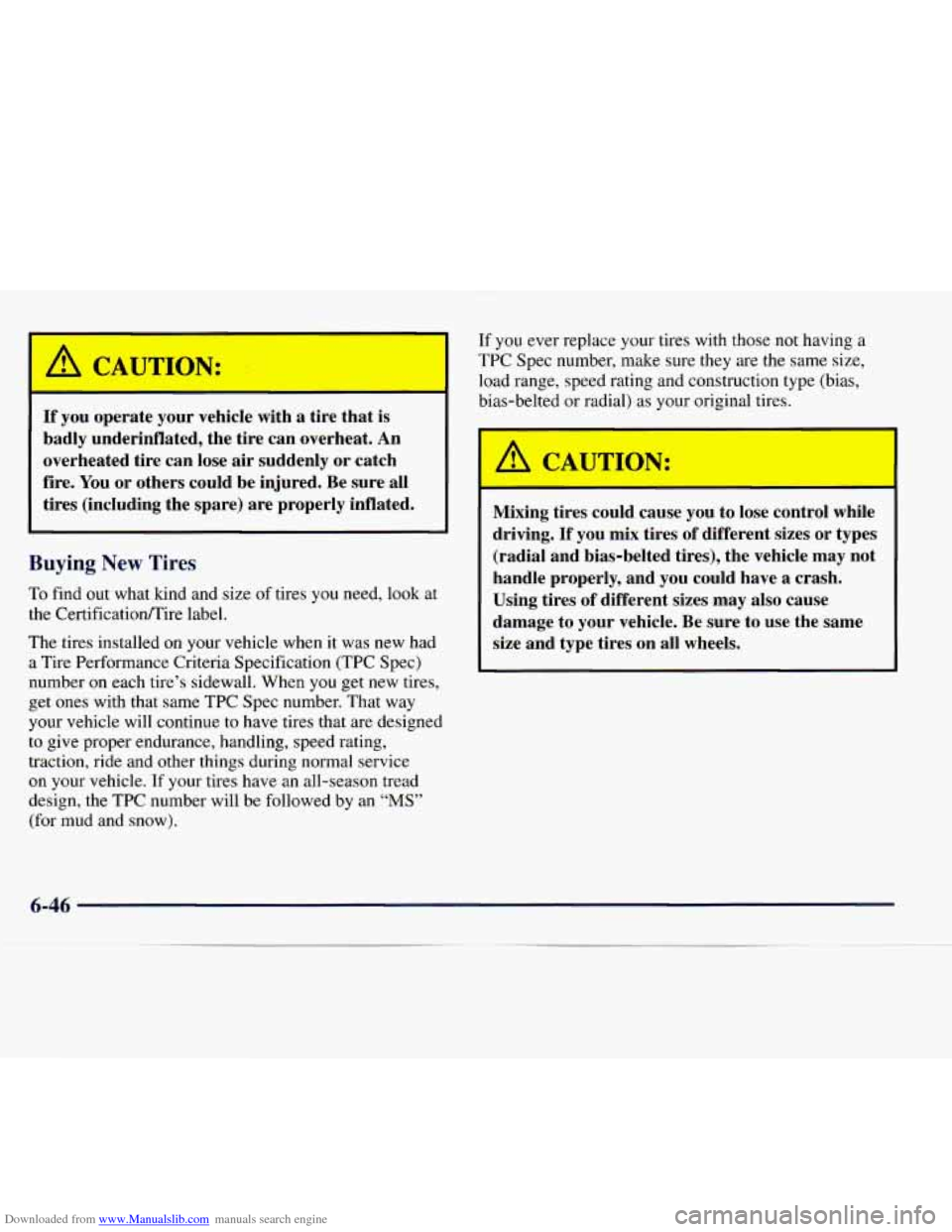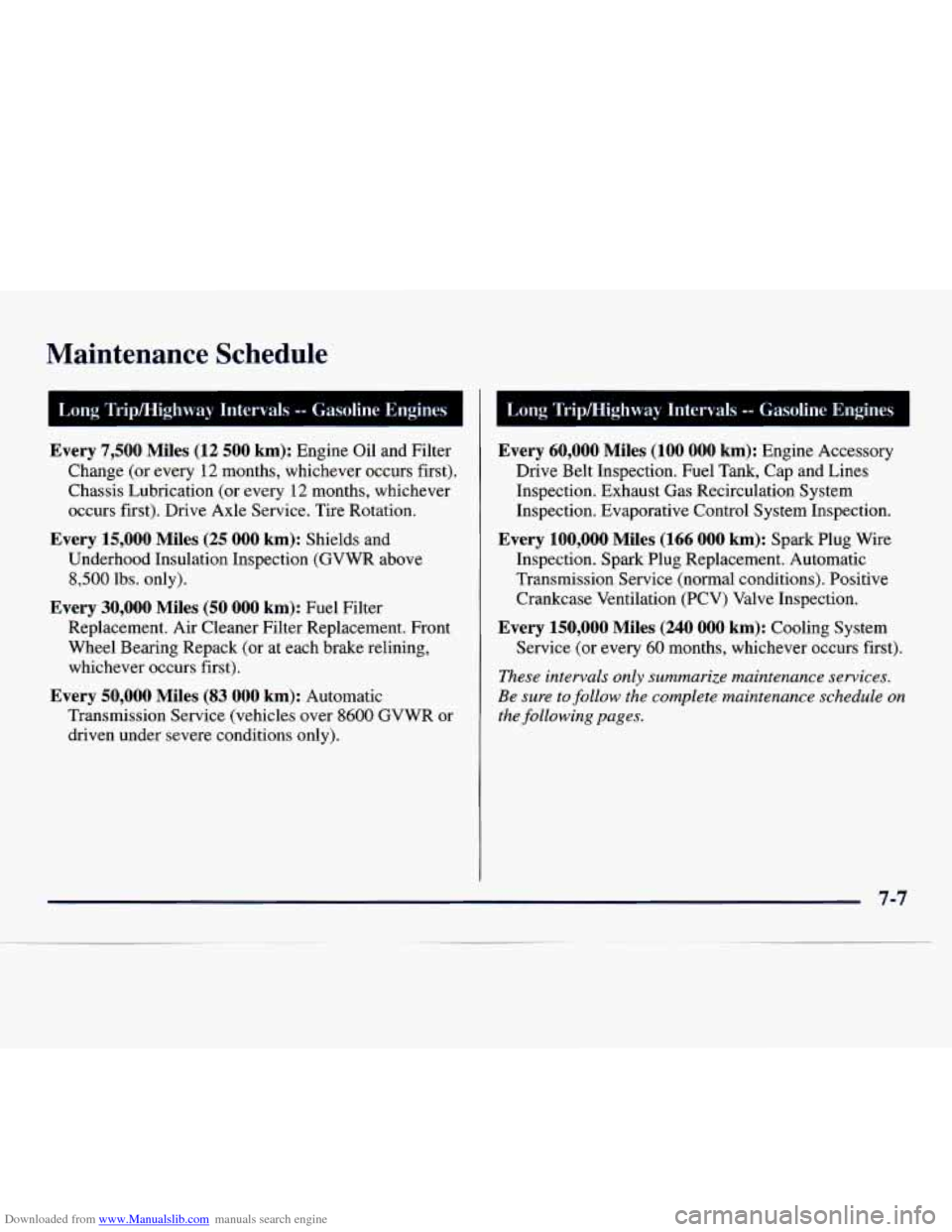1998 CHEVROLET EXPRESS belt
[x] Cancel search: beltPage 199 of 386

Downloaded from www.Manualslib.com manuals search engine Parking on Hills
You really should not park your vehicle, with a trailer
attached, on a hill. If something goes wrong, your
rig
could start to move. People can be injured, and both
your vehicle and the trailer can be damaged.
But
if you ever have to park your rig on a hill, here’s
how to do it:
1.
2.
3.
4.
5.
Apply your regular brakes, but don’t shift into
PARK (P) yet. Then turn your wheels into the curb if
facing downhill or into traffic if facing uphill.
Have someone place chocks under the trailer wheels.
When the wheel chocks are in place, release the
regular brakes
until the chocks absorb the load.
Reapply the regular brakes. Then apply your parking
brake and then shift to PARK
(P).
Release the regular brakes.
When You Are Ready to Leave After
Parking
on a Hill
1. Apply your regular brakes and hold the pedal down
while you:
Start your engine;
Shift into a gear; and
0 Release the parking brake.
2. Let up on the brake pedal.
3. Drive slowly until the trailer is clear of the chocks.
4. Stop and have someone pick up and store the chocks.
Maintenance When Trailer Towing
Your vehicle will need service more often when you’re
pulling a trailer. See the Maintenance Schedule for more
on this. Things that are especially important in trailer
operation are automatic transmission fluid (don’t
overfill), engine oil, axle lubricant, belt, cooling system
and brake adjustment. Each of these is covered in this
manual, and
the Index will help you find them quickly.
If you’re trailering, it’s a good idea to review these
sections before you start your trip.
Check periodically to see that all hitch
nuts and bolts
are tight.
4-36
Page 250 of 386

Downloaded from www.Manualslib.com manuals search engine If your vehicle has a 7.4 liter engine and air
conditioning, your vehicle will have a auxiliary
engine fan in addition to
the belt driven fan.
Before closing the hood, be sure all the filler caps
are on properly.
Then lift the hood to relieve pressure
on the hood prop.
Remove the hood prop from the slot in the hood and
return the prop to its retainer. Then just let the hood
down and close it firmly.
Noise Control System
The following information relates to compliance with
Federal noise emission standards for vehicles with a
Gross Vehicle Weight Rating
(GVWR) of more than
10,000 lbs. (4 536 kg). The Maintenance Schedule
provides information on maintaining the noise control
system
to minimize degradation of the noise emission
control system during the life
of your vehicle. The
noise control system warranty is given in your
Warranty booklet.
These standards apply only
to vehicles sold in the
United States.
Tampering With Noise Control
System Prohibited
Federal law prohibits the following acts or the causing
thereof
1.
2.
The removal or rendering inoperative by any person,
other than for purposes
of maintenance, repair or
replacement, of any device or element of design
incorporated into any new vehicle for the purpose
of noise control, prior
to its sale or delivery to the
ultimate purchaser or while it is in use; or
The use of the vehicle after such device or element
of design has been removed or rendered inoperative
by any person.
Among
those acts presumed to constitute tampering are
the acts listed below.
Insulation:
Removal of the noise shields or underhood insulation.
Engine:
Removal or rendering engine speed governor (if
equipped) inoperative
so as to allow engine speed to
exceed manufacturer specifications.
Page 285 of 386

Downloaded from www.Manualslib.com manuals search engine I A CAUTION:
If you operate your vehicle with a tire that is
badly underinflated, the tire can overheat.
An
overheated tire can lose air suddenly or catch
fire. You or others could be injured. Be sure all
tires (including the spare) are properly inflated.
Buying New Tires
To find out what kind and size of tires you need, look at
the CertificatiodTire label.
The tires installed
on your vehicle when it was new had
a Tire Performance Criteria Specification (TPC Spec)
number on each tire’s sidewall. When you get new tires,
get ones with that same TPC Spec number. That way
your vehicle will continue
to have tires that are designed
to give proper endurance, handling, speed rating,
traction, ride and other things during normal service
on your vehicle. If your tires have an all-season tread
design, the TPC number will be followed by an
“MS”
(for mud and snow). If you
ever replace your tires with those
not having a
TPC Spec number, make sure they are the same size,
load range, speed rating and construction type (bias,
bias-belted or radial) as your original tires.
Mixing tires could cause you to lose control while
driving.
If you mix tires of different sizes or types
(radial and bias-belted tires), the vehicle may not
handle properly, and you could have a crash.
Using tires
of different sizes may also cause
damage
to your vehicle. Be sure to use the same
size and type tires on all wheels.
Page 293 of 386

Downloaded from www.Manualslib.com manuals search engine Care of Safety Belts
Keep belts clean and d
I
Do not bleach or dye safety belts. If you do, it
may severely weaken them. In a crash, they
might not be able to provide adequate protection.
Clean safety belts only with mild soap and
lukewarm water.
Cleaning Glass Surfaces
Glass should be cleaned often. GM Glass Cleaner (GM
Part No. 1050427) or a liquid household glass cleaner
will remove normal tobacco smoke and dust films on
interior glass.
Don’t use abrasive cleaners on glass, because they
may cause scratches. Avoid placing decals on the inside
rear window, since
they may have to be scraped off later.
If abrasive cleaners are used on the inside
of the rear
window, an electric defogger element may be damaged.
Any temporary license should
not be attached across the
defogger grid.
Cleaning the Outside of the
Windshield and Wiper Blades
If the windshield is not clear after using the windshield
sap or other material may be on the blade
or windshield.
Clean the outside of the windshield with
GM Windshield
Cleaner, Bon
Ami@ Powder (non-scratching glass
cleaning powder),
GM Part No. 105OO11. The windshield
is clean if beads do
not form when you rinse it with water.
Grime from the windshield will stick
to the wiper blades
and affect their performance. Clean the blade by wiping
vigorously with a cloth soaked in full-strength windshield
washer solvent. Then rinse the blade with water.
I washer, or if the wiper blade chatters when running, wax,
Check the wiper blades and clean them
as necessary;
replace blades that look worn.
Weatherstrips
Silicone grease on weatherstrips will make them last
longer, seal better, and
not stick or squeak. Apply
silicone grease with a clean cloth at least every six
months. During very cold, damp weather more frequent
application may be required. (See “Recommended
Fluids and Lubricants’’
in the Index.)
Page 317 of 386

Downloaded from www.Manualslib.com manuals search engine Maintenance Schedule
I Short Trip/City Intervals -- Gasoline Engines I
Every 60,000 Miles (100 000 km): Engine Accessory
Drive Belt Inspection. Fuel Tank, Cap and Lines
Inspection. Exhaust Gas Recirculation System
Inspection. Evaporative Control System Inspection.
Every 100,000 Miles (166 000 km): Spark Plug Wire
Inspection. Spark Plug Replacement. Automatic
Transmission Service (normal conditions). Positive
Crankcase Ventilation (PCV) Valve Inspection.
Every 150,000 Miles (240 000 km): Cooling System
Service (or every
60 months, whichever occurs first).
These intervals only summarize maintenance services.
Be sure to follow the complete maintenance schedule on
the following pages.
bmng TripMighway Definition -- Gasoline Engines I
Follow this maintenance schedule only if none of the
conditions from the Short Trip/City Maintenance
Schedule is true.
Do not use this schedule if the vehicle
is used for trailer towing, driven in a dusty area
or used
off paved roads. Use the Short Trip/City schedule for
these conditions.
Driving a vehicle with a fully warmed engine
under highway conditions causes engine oil to break
down slowex
7-6
Page 318 of 386

Downloaded from www.Manualslib.com manuals search engine Maintenance Schedule
Long Tripmighway Intervals -- Gasoline Engines I
Every 7,500 Miles (12 500 km): Engine Oil and Filter
Change (or every
12 months, whichever occurs first).
Chassis Lubrication (or every 12 months, whichever
occurs first). Drive Axle Service. Tire Rotation.
Every 15,000 Miles (25 000 km): Shields and
Underhood Insulation Inspection (GVWR above
8,500 lbs. only).
Replacement. Air Cleaner Filter Replacement. Front
Wheel Bearing Repack (or at each brake relining,
whichever occurs first).
Transmission Service (vehicles over
8600 GVWR or
driven under severe conditions only).
Every 30,000 Miles (50 000 km): Fuel Filter
Every 50,000 Miles (83 000 km): Automatic
Long Tripmighway Intervals -- Gasoline Engines
Every
60,000 Miles (100 000 km): Engine Accessory
Drive Belt Inspection. Fuel Tank, Cap and Lines
Inspection. Exhaust Gas Recirculation System
Inspection. Evaporative Control System Inspection.
Every 100,000 Miles (166 000 km): Spark Plug Wire
Inspection. Spark Plug Replacement. Automatic
Transmission Service (normal conditions). Positive
Crankcase Ventilation (PCV) Valve Inspection.
Every 150,000 Miles (240 000 km): Cooling System
Service (or every
60 months, whichever occurs first).
These intervals only summarize maintenance services.
Be sure
to follow the complete maintenance schedule on
the following pages.
7-7
Page 329 of 386

Downloaded from www.Manualslib.com manuals search engine 1 Short TripKity Maintenance Schedule -- Gasoline Engines I
60,000 Miles (I00 000 km)
0 Change engine oil and filter (or every 3 months, whichever occurs first).
0 Lubricate chassis components (or every 3 months, whichever occurs first).
0 Check axle tluid level and add fluid as needed. (See footnote **.)
MILEAGE An Emission Control Service.
(See footnote #.)
0 Clean and repack the front wheel bearings (or at each brake relining,
whichever occurs first).
0 Vehicles With GVWR Above 8,500 lbs. Only: Inspect shields and underhood
insulation for damage or looseness. Adjust or replace as required.
This is a
Noise Emission Control Service. Applicable only to vehicles sold in the
United Stutes.
0 Inspect engine accessory drive belt.
0 Replace fuel filter.
0 Conduct Exhaust Gas Recirculation (EGR) system inspection as described in
An Emission Control Service.
An E~nission Control Service. (See footnote?.)
the service manual.
An Emission Control Service. (See footnote?.)
7-18
Page 344 of 386

Downloaded from www.Manualslib.com manuals search engine Long Tripmighway Maintenance Schedule -- Gasoline Engines
0 Rotate tires. See “Tire Inspection and Rotation” in the Index for proper
0 Inspect engine accessory drive belt.
0 Replace fuel filter.
0 Replace air cleaner filter.
rotation pattern and
additional information. (See footnote
+.)
An Emission Control Service.
An Emission Control Service.
(See footnote?.)
An Emission Control Service.
0 Inspect fuel tank, cap and lines for damage or leaks. Inspect fuel cap gasket
for any damage. Replace parts as needed.
An Emission Control Service. (See footnote?.)
0 Vehicles With GVWR Above 8,500 lbs. Only: Inspect shields and underhood
insulation for damage or looseness. Adjust
or replace as required. This is CI
Noise Emission Control Service. Applicable only to vehicles sold in the
United States.
0 Conduct Exhaust Gas Recirculation (EGR) system inspection as described in
the service manual.
An Emission Control Service. (See footnote?.)
0 Conduct evaporative control system inspection. Check all fuel and vapor lines
and hoses for proper hook-up, routing and condition. Check that the purge
valve works properly, if equipped. Replace as needed.
An Emission Control Service. (See footnote?.)
* 7-33